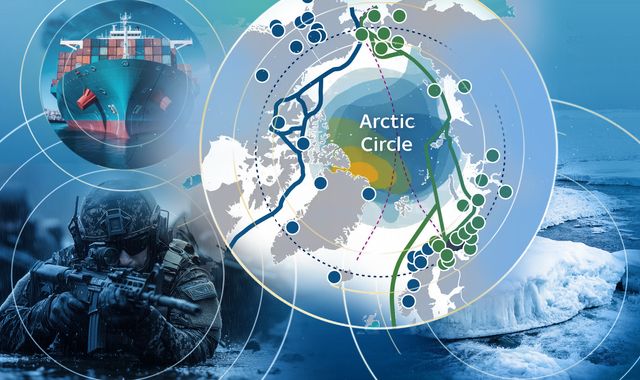Melting Arctic ice is opening up more routes for shipping and military vessels, and the potential to drill for new reserves of gas, oil and natural minerals in an otherwise virtually unspoilt ecosystem.
The continent has long been warming faster than the rest of the world.
As the sea ice disappears, its white surface that reflects sunlight gives way to darker ocean underneath that absorbs the heat instead.
Today the United Nations’ World Meteorological Organisation (WMO) warned the Arctic is on course to warm 3.5 times faster than the rest of the world over the next five years, making it at least 2.4C warmer than the recent average.
It comes as the UK’s Foreign Secretary David Lammy tours the region to assess threats from Russia and climate change, calling it an “increasingly important frontier for geopolitical competition and trade”.
On Tuesday he announced new UK funding to work with Iceland on monitoring Arctic waters, for AI to detect hostile state activity and for research on the impact on the UK.
Arctic melt is expected to push up sea levels around Britain’s coastline and fuel worse coastal flooding.
It will shift the jet stream, disrupting the UK’s weather system in ways not yet fully understood.
Read more: Melting Arctic ice caps helps predict UK heatwaves
Security threat ‘fundamentally changed’
Klaus Dodds, geopolitics professor at Royal Holloway, said less sea ice in the Arctic will likely attract “heightened commercial and military activity by third parties that are not allies of the UK, primarily Russia and China”.
He said the UK should prepare to operate in the region without the US as a reliable ally, while Russia will “continue to target critical infrastructure in the North Atlantic and European Arctic – all of which maybe ever more accessible”.
Ed Arnold from security thinktank RUSI said further melt will mean “that the Russians would have more control over [the Northern Sea Route]” via which ships can access waters around Britain.
The security threat is changing “pretty fundamentally” as vessels can more easily travel through the Arctic to waters containing gas pipelines or data cables supplying Europe, he added.
‘Shocking, but not shocking’
The WMO report also warned a dangerous new warming threshold was on the horizon for the first time.
Ten years ago, under the landmark Paris Agreement, world leaders promised to try to limit warming to no more than 2C above pre-industrial levels, and ideally stick to 1.5C.
At the time, both those thresholds felt a long way off.
But just 10 years later, today’s report forecasts for the first time ever a chance of breaching 2C of warming at some point in the next five years.
The chances are “exceptionally unlikely”, probably no more than 1%, said Prof Adam Scaife from the Met Office Hadley Centre, who worked on the report.
But such a forecast would have been “effectively impossible” just a few years ago, in a sign of how quickly the climate is changing.
Prof Scaife added: “It is shocking in that sense that two degrees is possible. However, it’s not shocking [because]… we thought it might be plausible at this stage, and indeed it is.”
And unless something changes dramatically, 2C will become increasingly likely, increasingly soon, the authors warned, driving more extreme weather and migration as homelands become unliveable.
The WMO also warned temperatures are likely to again hit 1.5C above pre-industrial levels over the next five years – after doing so temporarily in 2024.






























